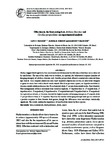Por favor, use este identificador para citar o enlazar este ítem:
http://www.alice.cnptia.embrapa.br/alice/handle/doc/1032741Registro completo de metadatos
| Campo DC | Valor | Lengua/Idioma |
|---|---|---|
| dc.contributor.author | PAROLIN, L. C. | pt_BR |
| dc.contributor.author | MIKICH, S. B. | pt_BR |
| dc.contributor.author | BIANCONI, G. V. | pt_BR |
| dc.date.accessioned | 2016-01-05T03:24:01Z | - |
| dc.date.available | 2016-01-05T03:24:01Z | - |
| dc.date.created | 2016-01-04 | pt_BR |
| dc.date.issued | 2015 | pt_BR |
| dc.identifier.citation | Anais da Academia Brasileira de Ciências, v. 87, n. 4, p. 2047-2053, 2015. | pt_BR |
| dc.identifier.uri | http://www.alice.cnptia.embrapa.br/alice/handle/doc/1032741 | pt_BR |
| dc.description | Studies suggest that frugivorous bats search and select fruit mainly by olfaction so that they can be attracted by smell alone. The aim of this study was to evaluate, in captivity, the behavioural response (number of foraging attempts) of Artibeus lituratus and Carollia perspicillata offered essential oils extracted from ripe fruit of Ficus insipida (Moraceae) and Piper hispidum (Piperaceae) as well as intact fruit wrapped in gauze to attract bats with reduced visual stimuli. Based on previous reports, we hypothesized that A. lituratus would exhibit preference for Ficus fruits/oil while C. perspicillata would prefer Piper fruit/oil. Four arrangements of these attractants were tested in triplicate: P. hispidum fruit vs. F. insipida fruit, P. hispidum oil vs. F. insipida oil, P. hispidum oil vs. F. insipida fruit and P. hispidum fruit vs. F. insipida oil. As expected, in all tests, A. lituratus showed the highest number of foraging attempts in F. insipida while C. perspicillata in those of P. hispidum. Based on the number of foraging attempts both species exhibited a positive response to their favorite fruit genera, though the differences were not always statistically significant. The results confirm the importance of smell in fruit choice by these species. | pt_BR |
| dc.language.iso | eng | eng |
| dc.rights | openAccess | eng |
| dc.subject | Artibeus lituratus | pt_BR |
| dc.subject | Carollia perspicillata | pt_BR |
| dc.subject | Bats | pt_BR |
| dc.subject | Food preference | pt_BR |
| dc.title | Olfaction in the fruit-eating bats Artibeus lituratus and Carollia perspicillata: an experimental analysis. | pt_BR |
| dc.type | Artigo de periódico | pt_BR |
| dc.date.updated | 2016-01-05T03:24:01Z | pt_BR |
| dc.subject.thesagro | Fruta | pt_BR |
| dc.subject.thesagro | Morcego | pt_BR |
| dc.subject.thesagro | Olfato | pt_BR |
| dc.subject.thesagro | Preferência Alimentar | pt_BR |
| dc.subject.thesagro | Óleo Essencial | pt_BR |
| dc.subject.nalthesaurus | essential oils | pt_BR |
| dc.subject.nalthesaurus | fruits | pt_BR |
| dc.subject.nalthesaurus | smell | pt_BR |
| riaa.ainfo.id | 1032741 | pt_BR |
| riaa.ainfo.lastupdate | 2016-01-04 | pt_BR |
| dc.identifier.doi | http://dx.doi.org/10.1590/0001-3765201520140519 | pt_BR |
| dc.contributor.institution | LAYS C. PAROLIN, Embrapa Florestas / Unesp / PUC-PR; SANDRA BOS MIKICH, CNPF; GLEDSON V. BIANCONI, Instituto Neotropical / Instituto Federal do Paraná. | pt_BR |
| Aparece en las colecciones: | Artigo em periódico indexado (CNPF)  | |
Ficheros en este ítem:
| Fichero | Descripción | Tamaño | Formato | |
|---|---|---|---|---|
| 2015SandraBAABCOlfaction.pdf | 850.03 kB | Adobe PDF |  Visualizar/Abrir |









